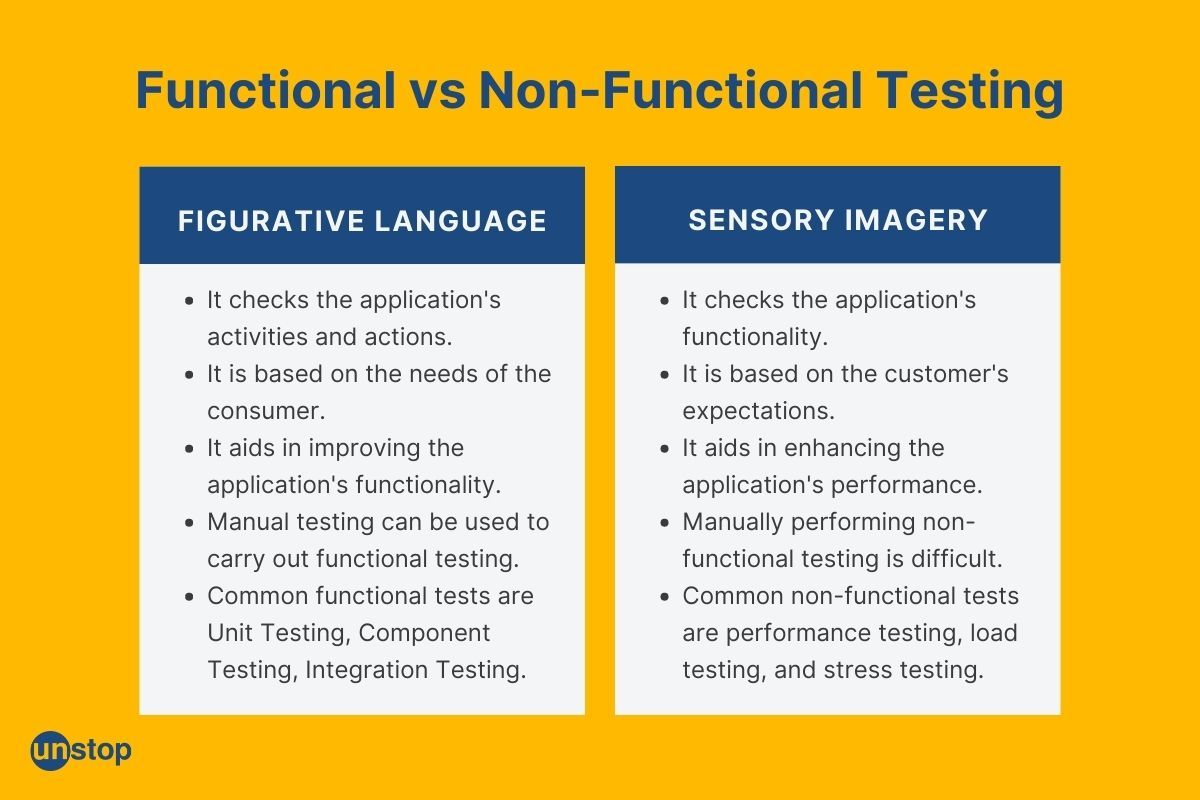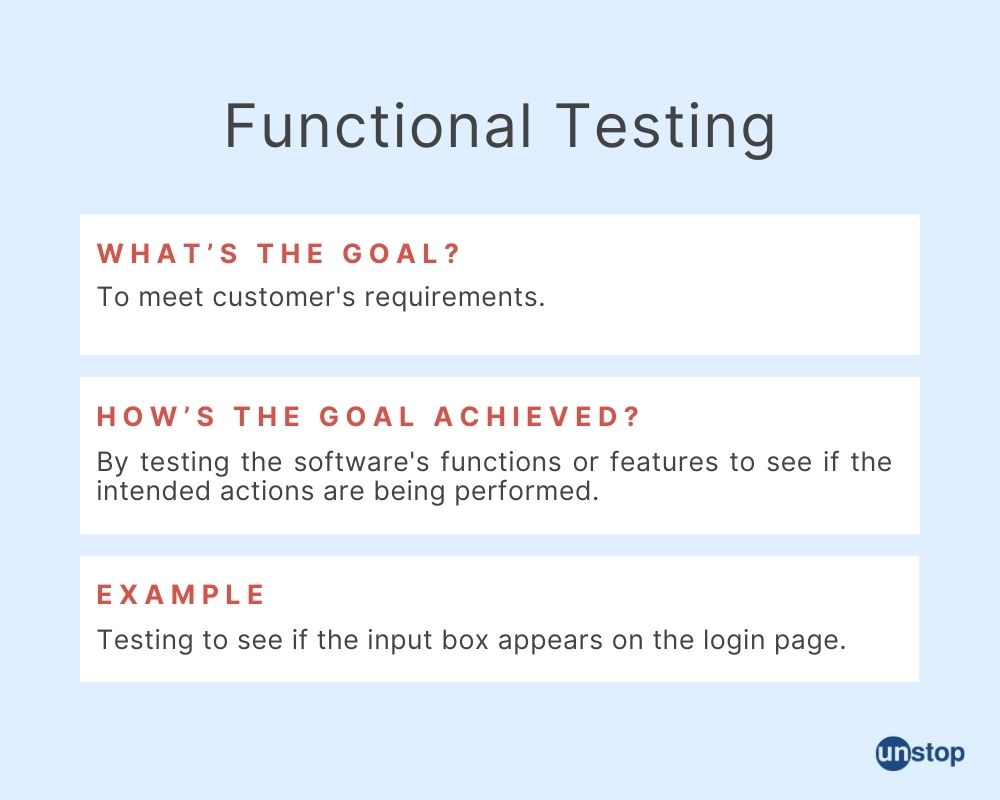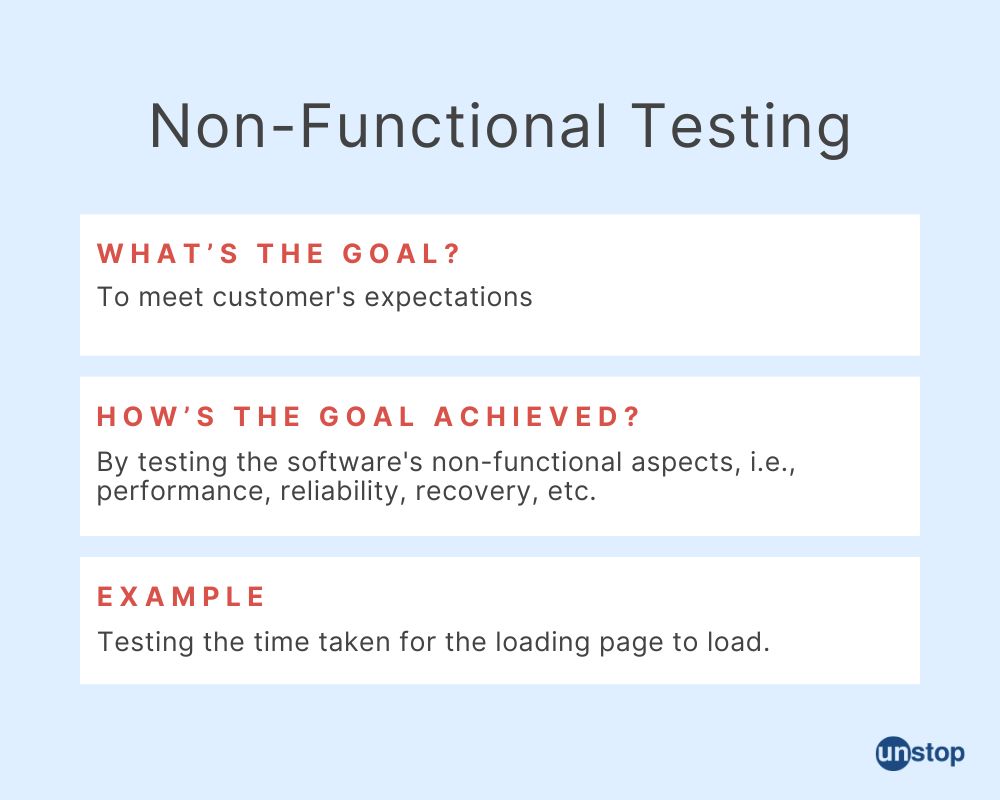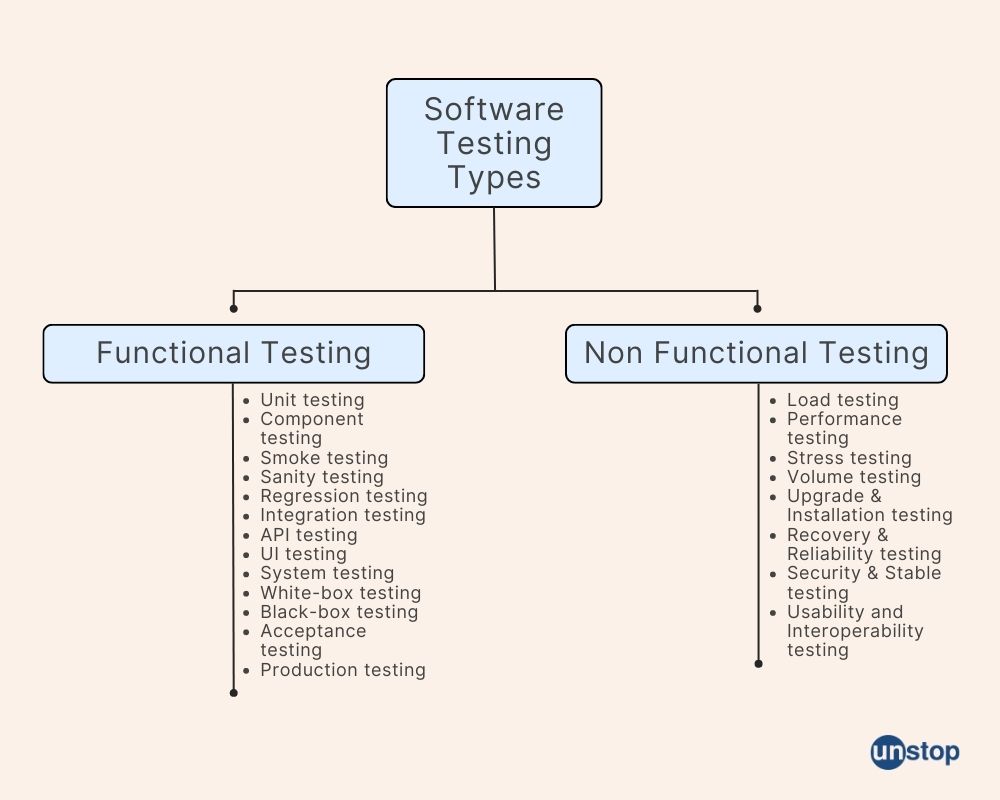- Key Difference Between Functional &Non-Functional Testing
- What Is Functional Testing?
- Types Of Functional Tests:
- What Is Non-Functional Testing?
- Types Of Non-Functional Testing
- Functional And Non-Functional Testing
Understanding The Difference Between Functional and Non-Functional Testing

Software testing is an important and crucial aspect of software development. It's the process of testing software (product or application) to ensure that it's working as intended. This includes testing the software product or application for bugs, performance issues, etc.
There are two important types of software testing: functional testing and non-functional testing. Both functional and non-functional testing can be utilized for quality assurance since they cover distinct areas of software systems. However, they can't both be utilized at the same time and both have their own advantages.
Key Difference Between Functional And Non-Functional Testing
The biggest difference between functional and non-functional testing is in their intent and end goal.
Functional testing evaluates and tests the software's functions or features to determine if the product or application is performing the intended actions. Thus, its goal is to meet customer's requirements. For example, testing a login page to check if the input box (to enter username and password) is appearing.
Non-functional testing evaluates and tests software's non-functional aspects, i.e., performance, reliability, recovery, etc. Thus, its goal is to meet customer's expectations. For example, testing the time taken for the loading page to load.
Let's understand the two types of software testing--functional and non-functional testing--in detail:
What Is Functional Testing?

Functional testing is software testing that involves comparing the system to its functional requirements and specifications. Functional testing ensures that the application satisfies all of the requirements.
This testing is unconcerned about the application's source code. Each software application's functioning is tested by giving adequate test input, anticipating the result, and comparing the actual output to the expected output.
It concentrates on simulating actual system operation, although it may also be used for other purposes. It focuses on simulating actual system utilization but makes no assumptions about system structure. It is a sort of testing that confirms that each function of a software program operates in accordance with the requirements and functional specifications.
Functional Requirements
The ultimate goal of functional testing is to ensure that software satisfies customer requirements and complies with specifications. While the goal appears straightforward, the work entails a variety of functional testing techniques, some of which may be favored or prioritized above others based on the application and organization.
The stability of the software, the extent of the modifications, or the business's schedules may influence your decision regarding various functional testing kinds — or how many people are engaged in each step.
For example, functional testing categories such as component, integration, and system testing, evaluate the software's ability to work in isolation or with other components. Therefore, the testing method may be determined by the app's interoperability requirements. Similarly, if a business undertakes system testing, it may not perform acceptability testing because the latter is redundant. Another example: production testing, alpha testing and beta testing, all refer to builds that are being tested in a real-world setting.
Types Of Functional Tests:
Here's a look at the different types of functional testing tests and what they entail:
1. Unit testing
Unit testing is the process of testing individual units before you test a complete software package, ensuring that various components function properly. The function of a unit is validated by unit testing, which ensures that the inputs (one to a few) result in the lone expected output. This form of testing lays the groundwork for more complicated integrated applications. When done properly, unit testing produces higher-quality application code and speeds up the development process. Unit tests are frequently carried out by developers using a codeless automation testing tool or automation testing methods.
2. Component testing
It refers to the testing of individual components. Component testing, also known as module testing, examines individual components of an application. Component testing, like unit testing, examines a piece of software in isolation from the rest of the system. The distinction between unit testing and component testing is that the former is performed in a white-box manner by developers to ensure that program modules run, while the latter is performed in a black-box testing method format by testers to validate specific objects or components of the product. If the component under test is dependent on other software components, the QA expert may use a stub and driver to mimic interactions between those components.
3. Smoke testing
Smoke testing a sort of acceptance testing used to ensure that the build and important functions of a new software are stable. If the smoke tests pass, the structure may go through more testing to validate other aspects of the software. Smoke testing, often known as build verification testing, is used to determine whether the new software's critical functionality meets its objectives. If the tests fail, further development effort is necessary.
4. Sanity testing
Sanity testing is a sort of regression testing in which QA specialists assess new functionality or bug fixes on new versions of stable releases. Sanity testing is unscripted and precisely targets the section that has undergone a code change. It's comparable to smoke testing in that both give a gate check that a build is ready for continued testing.
5. Regression testing
It's important to keep in mind that just because functional tests pass once doesn't mean they'll pass every time. Thus, you perform regression tests. Regression testing is when developers commit new code or update a feature to ensure the program continues to work as planned. Regression testing is beneficial as it guarantees that a product's stability is maintained when it is being modified. It's customary to use automated regression testing.
6. Integration testing
Integration testing is an important part of the development process. Integration testing is frequently carried out in conjunction with unit testing. QA specialists use integration testing to ensure that separate code modules function together effectively as a group. Microservices, which are self-contained apps that are meant to accomplish a single job, are used by many current applications. These microservices must interact with one another, otherwise, the application will fail.
Integrity testing ensures that these components work and communicate with one another in a smooth manner.
7. API testing
API testing is a critical component of the development process. Application programming interfaces (APIs) link multiple programs or systems together, and they're becoming more common as users want apps to work together. API testing verifies that API connections and answers work as expected, including how data and user rights are handled. It's usually done through automation tools, though in rare cases, manual testing may also be performed.
8. UI testing
This refers to testing the user interface. UI testing entails QA professionals engaging with the graphical interface of a software product. This involves testing UI components such as buttons, menus, and text input to ensure that the user experience flow and features chosen are optimum.
9. System testing
System testing involves QA specialists testing the program as a whole, as a complete product. Testers use this form of functional testing to ensure that the entire integrated software product fulfills requirements. Without knowing how the software or website was created, testers can give input on its operation and performance as needed. This aids teams in creating test cases that may be utilized in the future. End-to-end testing is another term for system testing.
10. White-box testing
White-box testing is when you test anything in a controlled environment. White-box testing occurs when the developer or tester can see the software's internal infrastructure, code, and design. This method combines multiple forms of functional testing, such as unit, integration, and system testing. The organization examines numerous parts of the program, such as established inputs and expected outputs, as well as decision branching, loops, and statements in the code, using a white-box testing technique.
11. Black-box testing
The black-box testing method, in contrast to white-box testing, includes testing against a system where the internal code, routes, and infrastructure are hidden. As a result, testers employ this technique to check predicted outputs against specified inputs. A black box situation occurs when a QA expert does not examine the code prior to testing. The business may test the software in a black-box environment via black-box testing.
Black-box testing allows an organization to evaluate software in the same way that a client would. Depending on the test's goal, black-box testing might include a number of non-functional and functional testing methods.
12. Acceptance testing
Acceptance testing's sole objective is to guarantee that the end-user can meet the business requirements goals.
Rather than focusing on the functionality of particular features, acceptance testing investigates the complete application flow and end-to-end experience. End users do their analysis of the final product during user acceptability testing (UAT) and beta testing, which are subcategories of acceptance testing. The company may then examine the input and make adjustments as a result.
12.a Alpha testing
Alpha testing is a subset of acceptance testing in which the product is evaluated by members of the internal team.
These members of the team should be familiar with the project but not participate in its development or testing. Alpha testing allows an immediate subset of testers to root out serious flaws before the product is noticed by external consumers, where certain releases may still be rather unstable.
12.b Beta testing
Beta testing includes testing the product with a small sample of end consumers after the internal team has tested the product and fixed any flaws. Beta testing is a kind of beta launch.
Beta testing acts as a beta release, allowing you to receive input from genuine users who have never used the software before. Beta testing helps you to obtain input from unbiased consumers who may engage with the product differently than you planned, maybe finding crucial undiscovered flaws before distribution to a large user base.
13. Production testing
This includes testing the final product. When the product is released to the public, it is in a live production environment where any user may interact with it in any manner they choose. Everything, from the testing environment to the number of individuals utilizing the product, is no longer within your control. Continuous testing and shift-right testing, which aims to find and triage user-reported faults as rapidly as possible, include production testing. The company may test beyond the written test cases in a diversified environment by testing in production. The company can check product functioning and stability through production testing.
What Is Non-Functional Testing?

Non-functional testing is a sort of software testing that verifies the application's non-functional aspects. It tests all of the aspects that aren't covered in the other tests. Its purpose is to evaluate a system's readiness using nonfunctional criteria not covered by functional testing. The importance of non-functional testing is equal to that of functional testing.
Non-functional testing should be quantitative, therefore subjective terms like "good," "better," and "best" should be avoided. It's doubtful that exact figures will be available at the outset of the requirement process.
When testing for non-functional elements, prioritizing the needs is critical. It's necessary to ascertain that quality attributes are accurately recognized.
Types Of Non-Functional Testing
Here's a look at the different types of non-functional tests and what they entail:
1. Performance Testing
The functioning of software components is examined during performance testing. These tests reveal weaknesses in the architecture and design of software. This is usually accomplished by:
a) Time-to-response measurements
b) Locating bottlenecks
c) Identifying the sources of failure in software quality
Performance testing helps confirm that the software is quick, scalable, stable, and dependable.
2. Load Testing
Load testing examines how the software performs under typical and peak loads. This is done to see how much work the program can manage without degrading performance. Load testing can be performed by running numerous apps at the same time, flooding a server with traffic, or downloading a huge number of files. Load testing is performed to guarantee that the software is quick and scalable.
3. Stress Testing
Stress testing examines how the software performs under extreme situations. The software's breaking point is determined by this value. It's critical to learn what occurs when the system is stressed. Is the appropriate error message displayed? Is the system broken? How will it be able to recover? Stress testing is done to figure out what occurs when a system goes down. This assures that the program can be recovered, is stable, and is dependable.
4. Volume Testing
When a large amount of data is introduced to the database, volume testing is used to see what happens to the system's performance. This is done to see what difficulties can arise as data quantities increase. Flood testing is another name for it. You can run volume tests to see if there is any data loss, warning, or error messages, or if there are any other issues. Volume tests ensure that systems respond as expected to specific data volumes. This is necessary in order to maintain performance and stability.
5. Security Testing
Security testing examines software for weaknesses that might allow data to be compromised. The purpose of security testing is to demonstrate that an attack will not occur. The following are examples of common security tests:
a) Vulnerability assessments
b) Scans for security
c) Testing for penetration
d) Assessment of the dangers
e) Audits of security
f) Hacking that is legal and ethical
It is critical to do these tests in order to establish a safe and reliable system.
6. Upgrade and Installation Testing
Upgrade and installation testing ensures that software will function properly on all computers. As a result, existing users are subjected to update testing. New users are also subjected to installation testing. These two types of testing are critical for user satisfaction.
7. Recovery and Reliability Testing
Recovery Testing: The speed with which software can recover after a crash or failure is determined via recovery testing. This is accomplished by causing the system to crash. This sort of testing is carried out to determine what occurs:
a) If you unplug the hardware and if it will affect the software.
b) If you disconnect from the network while transferring data.
c) When the system is suddenly restarted.
Software performance may be improved by doing recovery tests.
Reliability Testing: The degree to which a software system executes the prescribed operations without fail over time is verified using Reliability Testing.
8. Stability and Security Testing
Security Testing is used to verify that the system is protected from purposeful and unexpected assaults from both internal and external sources.
Stability Testing verifies the degree to which a user may rely on a system when it is in use.
9. Usability and Interoperability Testing
Usability Testing examines the composition of the software system that may be adapted for usage in another application. Interoperability Testing examines how a piece of software interacts with other pieces of software.
Characteristics of non-functional testing
- Non-functional testing helps improve the product's usability, efficiency, maintainability, and portability.
- It reduces the risk and expense of manufacturing associated with non-functional components of the product.
- Optimizes installation, setup, execution, management, and monitoring of the product.
- Measurements and metrics are collected and produced for internal research and development.
- Improves and expands your understanding of product behavior and technology.

Functional And Non-Functional Testing: Differences
Here are the main differences between functional and non-functional testing:
| Criteria | Functional Testing | Non-Functional Testing |
| Purpose | It checks the application's activities and actions. | It checks the application's functionality. |
| Customer Needs | It is based on the needs of the consumer. | It is based on the customer's expectations. |
| End Result | It aids in improving the application's functionality. | It aids in the enhancement of the application's performance. |
| Difficulty | Manual testing can be used to carry out functional testing. | Manually performing non-functional testing is difficult. |
| Testing Types | The most common functional tests are Unit Testing, Component Testing, and Integration Testing. | There are multiple testing types, but some of the most common non-functional tests are - performance testing, load testing, and stress testing. |
Summing Up
- In functional testing, the requirements are defined by the user. In non-functional testing, requirements are defined by software engineers, developers, software architects, and other technical professionals.
- In functional testing, a use case can be used to document and understand the situation. Non-functional requirements, on the other hand, can be recorded and understood as a quality characteristic.
- Functional testing helps understand the system's functions. Non-functional testing, on the other hand, enables us to understand the system's performance.
- For functional testing, it's important to specify the features that a system should have. For non-functional testing, it's important to describe how the product should function (how it should behave).
- Functional requirements ensure that the system will suit the needs of the users. Non-functional requirement ascertains that the product satisfies the customer's expectations.
- Functional requirements are critical to the system's functionality. Non-functional requirements, on the other hand, may not always be essential.
- For functional testing to be successful, it's important to meet the standards. In non-functional testing, it is not necessary to meet these standards - although that may be preferable.
- Functional testing requires defining the system or one of its components. Non-functional requirements outline the system's performance characteristics.
You may also like to read:
- What Is The Difference Between Encryption And Hashing?
- What Is Data Independence In DBMS? Understand Its Importance With Examples
- Importance Of Data Transformation In Data Mining
- Difference Between Scripting And Programming Language | Why Scripting Language Is Considered A Programming Language But Not Vice-Versa?
As a biotechnologist-turned-writer, I love turning complex ideas into meaningful stories that inform and inspire. Outside of writing, I enjoy cooking, reading, and travelling, each giving me fresh perspectives and inspiration for my work.
Login to continue reading
And access exclusive content, personalized recommendations, and career-boosting opportunities.
Subscribe
to our newsletter
Blogs you need to hog!

This Is My First Hackathon, How Should I Prepare? (Tips & Hackathon Questions Inside)

10 Best C++ IDEs That Developers Mention The Most!

Advantages and Disadvantages of Cloud Computing That You Should Know!













Comments
Add comment